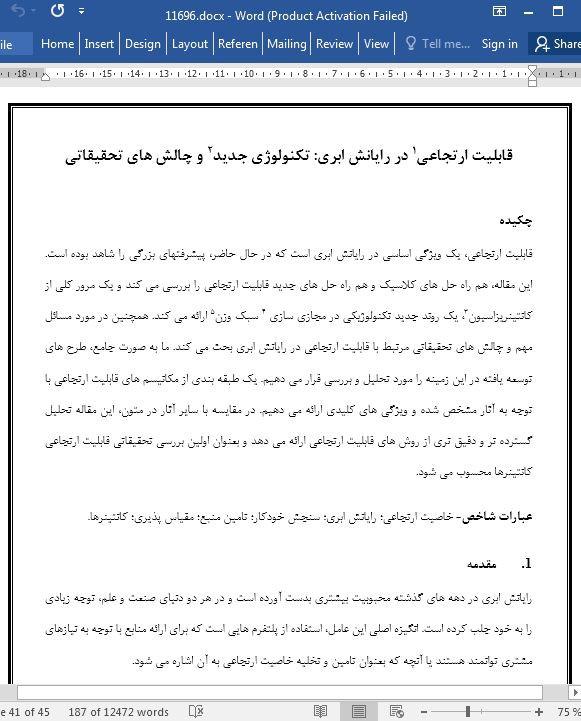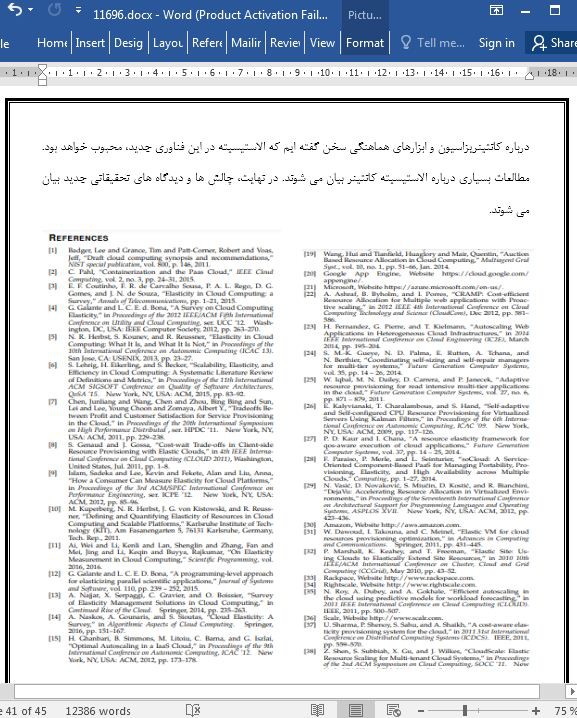
قابلیت ارتجاعی در رایانش ابری: تکنولوژی جدید و چالش های تحقیقاتی
چکیده
قابلیت ارتجاعی، یک ویژگی اساسی در رایانش ابری است که در حال حاضر، پیشرفتهای بزرگی را شاهد بوده است. این مقاله، هم راه حل های کلاسیک و هم راه حل های جدید قابلیت ارتجاعی را بررسی می کند و یک مرور کلی از کانتینریزاسیون ، یک روند جدید تکنولوژیکی در مجازی سازی سبک وزن ارائه می کند. همچنین در مورد مسائل مهم و چالش های تحقیقاتی مرتبط با قابلیت ارتجاعی در رایانش ابری بحث می کند. ما به صورت جامع، طرح های توسعه یافته در این زمینه را مورد تحلیل و بررسی قرار می دهیم. یک طبقه بندی از مکانیسم های قابلیت ارتجاعی با توجه به آثار مشخص شده و ویژگی های کلیدی ارائه می دهیم. در مقایسه با سایر آثار در متون، این مقاله تحلیل گسترده تر و دقیق تری از روش های قابلیت ارتجاعی ارائه می دهد و بعنوان اولین بررسی تحقیقاتی قابلیت ارتجاعی کانتینرها محسوب می شود.
1. مقدمه
رایانش ابری در دهه های گذشته محبوبیت بیشتری بدست آورده است و در هر دو دنیای صنعت و علم، توجه زیادی را به خود جلب کرده است. انگیزه اصلی این عامل، استفاده از پلتفرم هایی است که برای ارائه منابع با توجه به نیازهای مشتری توانمند هستند یا آنچه که بعنوان تامین و تخلیه خاصیت ارتجاعی به آن اشاره می شود. بنابراین، خاصیت ارتجاعی، یکی از ویژگی های کلیدی در رایانش ابری است که به صورت پویا، میزان منابع اختصاص داده شده را برای برآوردن تغییرات در تقاضاهای بار کاری تنظیم می کند [1].
6. نتیجه گیری
رایانش ابری به سرعت محبوب می شود، و توسط بسیاری از شرکت ها مورداستفاده قرار می گیرد. ویژگی کلیدی که پلتفرم های ابری را جذاب می کند، الاستیسیته است. الاستیسیته اجازه ارائه منابع الاستیک را با توجه به نیازها، به روشی بهینه می دهد. در این مقاله، یک مطالعه جامع درباره الاستیسته ارائه می شود. این مطالعه با گفتگو درباره تعاریف الاستیسیته آغاز می شود، و با عبارات مقیاس پذیری و کارایی مرتبط می شود. ما یک طبقه بندی گسترده را برای استراتژی های الاستیسیته براساس راه حل های تجاری و علمی موجود، پیشنهاد کرده ایم. طبقه بندی یا دسته بندی پیشنهادی، بسیاری از ویژگی ها و جنبه های الاستیسیته ابری را براساس تحلیل فرضیه های گوناگون، پوشش می دهد. سپس، هر جنبه از فرض های پیشنهادی، با جزئیات در نمونه های ارائه شده مورد بحث قرار می گیرد که الاستیسیته ابری را مدیریت می کند. ما درباره کانتینریزاسیون و ابزارهای هماهنگی سخن گفته ایم که الاستیسیته در این فناوری جدید، محبوب خواهد بود. مطالعات بسیاری درباره الاستیسیته کانتینر بیان می شوند. در نهایت، چالش ها و دیدگاه های تحقیقاتی جدید بیان می شوند.
Abstract
Elasticity is a fundamental property in cloud computing that has recently witnessed major developments. This article reviews both classical and recent elasticity solutions and provides an overview of containerization, a new technological trend in lightweight virtualization. It also discusses major issues and research challenges related to elasticity in cloud computing. We comprehensively review and analyze the proposals developed in this field. We provide a taxonomy of elasticity mechanisms according to the identified works and key properties. Compared to other works in literature, this article presents a broader and detailed analysis of elasticity approaches and is considered as the first survey addressing the elasticity of containers.
INTRODUCTION
CLOUD computing has been gaining more popularity in the last decade and has received a great deal of attention from both industrial and academic worlds. The main factor motivating the use of cloud platforms is their ability to provide resources according to the customer’s needs or what is referred to as elastic provisioning and deprovisioning. Therefore, elasticity is one of the key features in cloud computing that dynamically adjusts the amount of allocated resources to meet changes in workload demands [1].
6 CONCLUSION
Cloud computing is becoming increasingly popular; it is being used extensively by many enterprises with a rapid growing. The key feature that makes cloud platforms attractive is elasticity. Elasticity allows providing elastic resources according to the needs in an optimal way. In this article, a comprehensive study about elasticity is provided. It started by talking about the elasticity definitions, and its related terms scalability and efficiency. We have suggested an extended classification for the elasticity strategies based on the existing academic and commercial solutions. The proposed classification or taxonomy covers many features and aspects of the cloud elasticity based on the analysis of diverse proposals. Each aspect is then discussed in details providing examples from the proposed proposals that handle cloud elasticity. We have talked about the containerization and the orchestration tools where elasticity will be popular in this new technology. Many works on the container elasticity are presented. Finally, challenges and new research perspectives are presented.
چکیده
1. مقدمه
2. خاصیت ارتجاعی (الاستیسیته)
2.1. تعریف الاستیسیته و عبارت مرتبط با آن
2.2. طبقه بندی الاستیسیته
2.3. ارزیابی عملکرد الاستیسیته
3. کانتینریزاسیون
3.1. مزایا و معایب
3.2. فناوری های کانتینر
3.3. هماهنگی کانتینر و ابزارهای مدیریتی
3.4. الاستیسیته کانتینرها
4. مباحث باز و چالش های تحقیقاتی
5. مطالعات مرتبط
6. نتیجه گیری
Abstract
1 INTRODUCTION
2 ELASTICITY
2.1 Elasticity definition and its related terms
2.2 Elasticity taxonomy
2.3 Elasticity performance evaluation
3 CONTAINERIZATION
3.1 Pros and Cons
3.2 Container technologies
3.3 Container orchestration and management tools
3.4 Elasticity of containers
4 OPEN ISSUES AND RESEARCH CHALLENGES
5 RELATED WORK
6 CONCLUSION
- اصل مقاله انگلیسی با فرمت ورد (word) با قابلیت ویرایش
- ترجمه فارسی مقاله با فرمت ورد (word) با قابلیت ویرایش، بدون آرم سایت ای ترجمه
- ترجمه فارسی مقاله با فرمت pdf، بدون آرم سایت ای ترجمه



